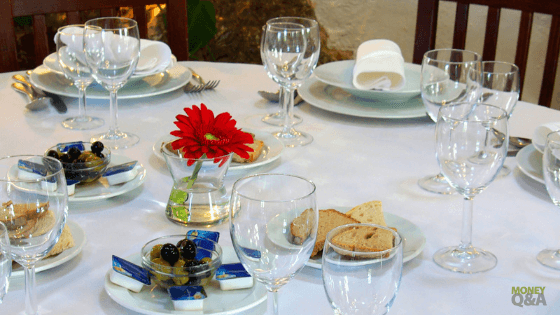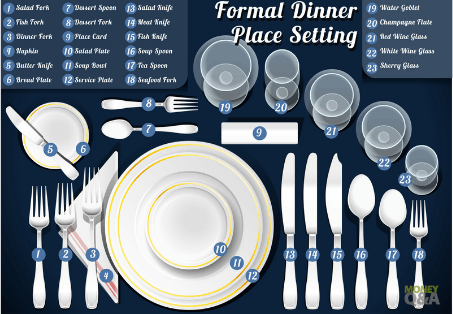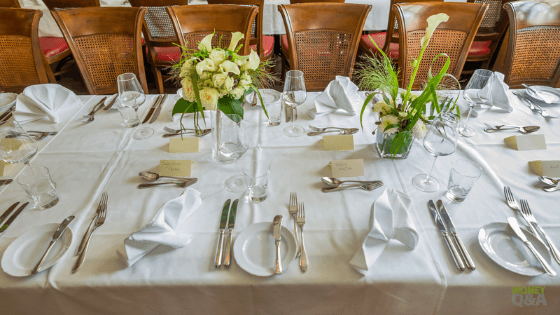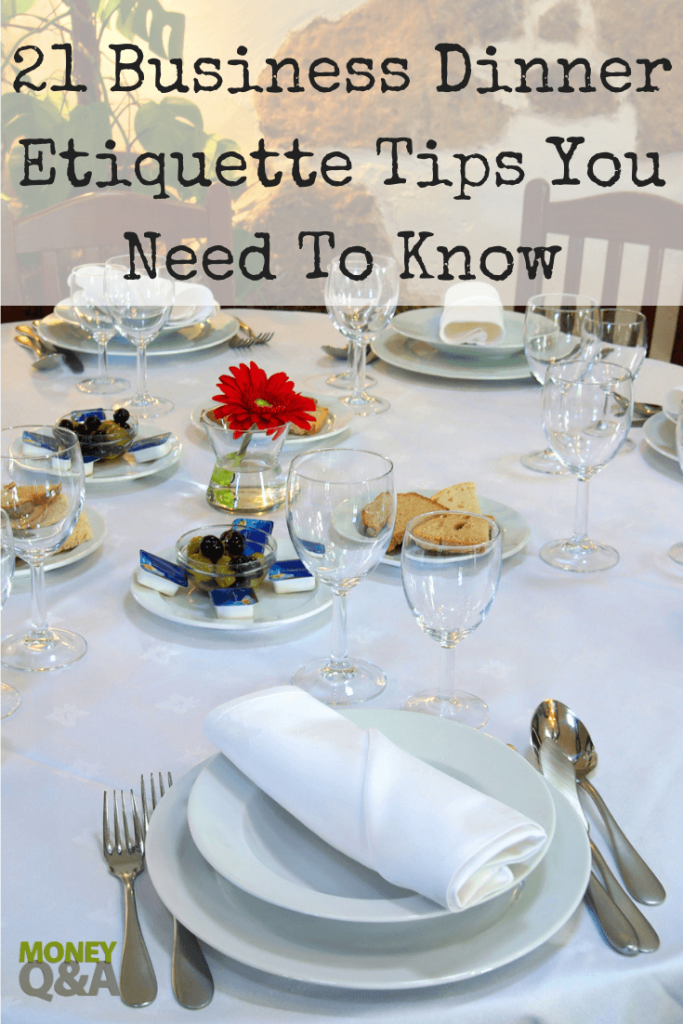
Dining etiquette is a set of rules to follow when dining in a formal setting. The formal dining room and dining table are often used to entertain guests, interview for a new job, or conduct business meetings. When dining, it is important to maintain good manners at all times – not just during the meal but also before and after the meal. Maintaining a gracious demeanor with proper business dinner etiquette throughout your meal will ensure you conduct yourself in a manner that portrays you in a positive light!
Dining etiquette is one of the most important aspects of business. It’s essential to know how to conduct yourself when dining with a new client or even an old acquaintance who could be potential future clients. This blog post covers some of the basics and will hopefully help your next dinner go off without a hitch!
Business dinner etiquette is a science and an art. There are many things to consider, from the table setting to how long one should chew their food before swallowing. It all depends on what type of dinner you’re attending, who your company is, and your relationship with them.
The Ultimate Dining Etiquette Guide
Business dinners are a big deal, and they can be tricky. It’s important to know the right things to do when you’re faced with business dinner etiquette. Some of these points may seem like no-brainers, but it doesn’t hurt to reiterate them for good measure! Remember: just because it feels natural at work does not mean that it will translate well outside the office environment!
This blog post will give you some pointers on how to navigate this difficult scenario successfully. Here are 21 tips for surviving your next business dinner.
Rule # 1 – Start on the Outside
On a properly set the table, you’ll typically find a fork on the left side of your plate and spoons and knives on the right. The basic guideline is to start working from the outside in. The first course is served with cutlery that is furthest away from your table. Understanding the place setting is critical to dining etiquette.

Rule # 2 – Build Bridges, Not Ramps
Place the entire utensil on the plate (bridge) when you put your knives, forks, and spoons down. Do not rest it half on and half off the plate (ramp). Instead, place it completely on the plate.
The dining fork is held in the left hand, cutting food with its edge facing down. The knife stays in the right hand for pushing food onto the fork. When you’re done, tuck your knife and fork together in the center of the table, so they’re slightly tilted to 5 o’clock.
Use the finished position (forks below the knives, diagonally across the plate) to signal that you’re done eating. This alone will take your dining etiquette to the next level and show your host that you know proper etiquette at the table.
Rule # 3 – Cutting Your Food
Use them both together at all times. It would be best if you did not chop your meal up before utilizing your knife and fork. Only one edible piece of meat may be cut at a time.
Cut only one piece at a time when you’re dining. Cutting multiple pieces of food on your plate at once doesn’t demonstrate any lack of etiquette. But doing so does show that you might not have proper table manners. Using cutlery with dining etiquette is important and demonstrates good taste to do so.
Rule # 4 – Eating Soup
When eating soup, start by pushing your spoon away from you and moving it to the farthest edge of the bowl. Take the spoon to your mouth and drink the soup from the edge of the spoon rather than putting all of it into your mouth. Also, do not slurp.
Rule # 5 – Using Napkins
In business dinner etiquette, your napkin should be unfolded and placed on your lap as soon after sitting down as possible, folded in half once, and the open end of the fold facing away from you. It’s never appropriate to tuck your napkin into the front of your shirt at a business dinner.
Place your napkin on your seat if you must leave the table before you’ve finished. This informs the server that you intend to return. This is a critical piece of dining etiquette to know and practice.
Rule # 6 – Which Glass to Use?
Normally, you’ll have two or more glasses on the table. Your glassware is on the right upper side of your plate. Up to four glasses may be utilized. They’re usually placed in a diagonal or square formation. The red wine goes in the top left glass.
A wine glass will generally be quite large. The white wine glass, which is smaller, will be positioned right below it. On the top right side, you’ll notice a champagne glass. Water glasses are located at the bottom right corner of the table.

Rule # 7 – Sitting Down
You should not sit in your seat until the host or hostess has done so. If there is no host, you should wait for the senior or oldest person at the table to take a seat before sitting down.
As a rule of thumb, you should never sit down at the dining table until all diners present have been seated.
Rule # 8 – Starting to Eat
You should not begin eating until the host, hostess, or senior guest at the table does so. You must not start eating until everyone has been served, even if your dish is becoming cold. If there are many people at a meal, the host may tell you to begin before everyone has been served. If this happens, you should start.
Rule # 9 – Spitting Food Out
If you take a bite of food that you can’t swallow, remove the chunk of food by whatever method it entered your mouth. Do not spit it on the dining table or your plate. In some dining situations, a napkin may be used to remove food from the mouth before disposing of it in an appropriate location.
Rule # 10 – Bread and Butter
When eating bread or other cuisines from a common basin in business dinner etiquette, you should offer the bread basket to the individual on your left and then pass the bowl around the table to the right.
If you have bread with your meal, there will almost always be a tiny side plate on the left of your place setting. If it’s served in loaf form, don’t cut it with a knife. Take a bite-sized piece off with your fingers if you wish to eat it.
Use your butter knife to transfer a decent amount of butter onto your bread. After that, one gets butter from the dish again. As a result, make sure you get enough. Place it on the side of your dinner plate. Rather than buttering all of your bread in advance, spread it with butter as you go along.
Rule # 11 – Ordering
When dining in a restaurant for business, you should not order the most expensive option. When dining at someone’s home, try to place your order last. Do not eat anything before telling the host that everything looks delicious. And, say it is delicious after taking at least one bite. Accept seconds when appropriate and send compliments to the chef with everyone else who tastes it as well.
Being generous will come back tenfold later if they taste something you didn’t like or just want an extra side of. During informal events, simply thank the host for their time and effort when they offer (or insist) on ordering for you.
Rule # 12 – Table Setting
The foods at the left of the dinner plate are to be considered. The words food and left each have four letters. Your bread or salad, as well as any other dish, will be placed to the left of your dinner plate if the table is properly set.
Additionally, glass and right have five letters in common. Drinks are set to the right of the dinner plate, and glasses and rights both contain five letters. The phrase glass and straight refers to alcoholic beverages.
Rule # 13 – Let the Wait Staff Will Take Care of You
When dining out in a business dinner setting, your dining experience and satisfaction is dependent on the wait staff assigned to your table. While some business dinner etiquette may be required from you during the meal (i.e., removing your napkin from your lap before placing it on the table), everything else is up to them – where they place food on the plate, how they serve it, etc.
As long as everyone’s glass remains full and no one’s water bowl runs dry while dining business dinner etiquette rules are required for everyone at the table, but it belongs to the wait staff. It would be best if you never tried to interfere with service or suggest how they do their job. Your goal is simply to enjoy yourself.
Rule # 14 – Shake Hands and Introduce Your Company (Optional)
Wait staff dining etiquette starts with your introduction to the dining room at large. If you are dining in a group, try to introduce everyone seated at the table as a member of your company. This makes for an easy transition when it comes time for introductions between dining partners later in the meal. For example, saying, “Hi everyone – I’m John from Acme Widgets” is both friendly and helps make things run smoother later on during dining partner introductions.
Rule # 15 – Watch Your Hands and Elbows
At the dining table, keep both hands visible at all times. Make sure you are sitting comfortably and aware of where everything is before starting your meal. You should also have a firm grip on the table you are dining at to make it easier for yourself to get up if there’s an emergency.
Never place your elbows on the dining table while dining. Do not lean on your elbows, as this can be considered rude. There could be an emergency situation (such as choking or falling) where it would be difficult to reach down without leaning over. If possible, try to avoid using this position altogether during dining etiquette.
Rule # 16 – Food on Adjacent Plates
Avoid placing food on adjacent diners’ plates when serving yourself from common dishes such as large platters or bowls.
Do not take more than your share of food from the common dishes. Usually, it is considered polite to leave at least a little bit left over for other dining companions to share or try as well. If for some reason, you need additional food, ask for it to be served onto your own plate rather than taking it directly off the serving spoon, platter, etc.
Rule # 17 – Avoid Talking About Politics, Religion, Money, or Sex
At the table, avoid talking about politics, religion, sex, or any other contentious topics. Business-related dining etiquette is all about making the meal enjoyable for everyone without offending anyone.
Asking your dining companions what they do as part of the conversation makes sense and broadens the discussion topics. When dining with a client or a boss, make sure to avoid talking about sensitive topics such as salary and benefits (as well as perks like family leave). You don’t want to come off like you are angling for an increased benefit package.
Remember that dining etiquette isn’t just table manners. It’s about enjoyably interacting with your dining companions and being cognizant of your dining partners’ feelings while still maintaining appropriate boundaries.
Rule # 18 – Don’t Order Difficult Foods
Some foods may be challenging to consume. By just avoiding those meals, you’ll save yourself time and embarrassment. For example, be careful eating hot soup or another hot item from the menu. Don’t blow on hot food to cool it down. Instead, allow it to cool down on its own.
To avoid dining mistakes, be careful about ordering foods that are difficult to cut or chew. Eating in a restaurant can be far more formal and challenging than dining with family members or friends. You need to be especially aware of what is expected regarding dining etiquette at a business dinner, so you don’t make any dining mistakes.
Don’t order messy foods. In addition to avoiding foods that are difficult to eat, keep an eye on the food’s appearance when deciding what will work best for your dining needs. Avoid ordering messy dishes that might leave stains on your clothing if you’re dining in business attire. For example, ribs can easily ruin good clothes, so it’s best to play it safe by skipping over them when
Rule # 19 – Don’t Ask for a To-Go Box
You’re not there for the leftovers. You’re there for business. Family dinners are fine for doggie bags, but they aren’t appropriate for professional gatherings. It would be best if you never asked for a to-go box unless dining in the home of a very close friend. In that case, it’s perfectly okay to ask, and both parties will understand.
Rule # 20 – The Host Should Pay
Paying for the meal can be tricky when considering dining etiquette. If you invited someone, you are the host and should pay the bill, regardless of gender. The bottom line is that you don’t want to quarrel about a payment. Feel free to take care of the check away from the table, which may be a classier way to pay if you are the host.
Rule # 21 – Thank the Wait Staff
If dining at a restaurant, be sure to thank the wait staff for the meal and their service. A quick trip to the restroom is a good time to leave an additional gratuity. Restaurants will usually have a jar of tip change on hand, which you can use to drop off an appropriate amount — generally, 15% or more if everyone in your party was pleased with their food and service. If you are dining at someone’s house, it is gracious to thank the host and offer to host another dinner in return as soon as possible.
Thanking the wait staff is a dining etiquette rule that many people often forget to follow. Follow these simple steps, and you’ll be sure to impress at your next dining experience. Being generous will come back tenfold later if they taste something you didn’t like or just want an extra side of. During informal events, simply thank the host for their time and effort when they offer (or insist) on ordering for you.
Conclusion
It’s important to remember dining etiquette when dining with clients, your boss, or during a job interview. Be sure to thank the wait staff at the end of a meal. Overall though, try not to make too big a deal out of anything because that could also come across as being demanding which would put off some people in business settings where relationships are key!
Dining etiquette in business settings will impress your boss or future boss with your manners and knowledge of dining etiquette. But be sure not to go overboard! Just follow the basic rules of dining etiquette above, and you should be ok.
Dining is an extremely important part of business meetings because it sets the mood for future business interactions between people who may be able to help one another and/or give each other opportunities. Whenever you’re eating with your superiors or clients, dining etiquette should always be followed. Your business dinner etiquette knowledge will get better over time as long as you practice!

